Conventional transistor overview and special transistors
Question 1:
A microcontroller is a specialized type of digital computer used to provide automatic sequencing or control of a system. Microcontrollers differ from ordinary digital computers in being very small (typically a single integrated circuit chip), with several dedicated pins for input and/or output of digital signals, and limited memory. Instructions programmed into the microcontroller's memory tell it how to react to input conditions, and what types of signals to send to the outputs.
The simplest type of signal ünderstood" by a microcontroller is a discrete voltage level: either "high" (approximately +V) or "low" (approximately ground potential) measured at a specified pin on the chip. Transistors internal to the microcontroller produce these "high" and "low" signals at the output pins, their actions being modeled by SPDT switches for simplicity's sake:
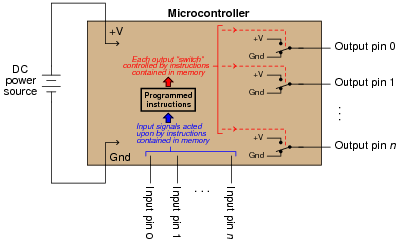
|
|
It does not require much imagination to visualize how microcontrollers may be used in practical systems: turning external devices on and off according to input pin and/or time conditions. Examples include appliance control (oven timers, temperature controllers), automotive engine control (fuel injectors, ignition timing, self-diagnostic systems), and robotics (servo actuation, sensory processing, navigation logic). In fact, if you live in an industrialized nation, you probably own several dozen microcontrollers (embedded in various devices) and don't even realize it!
One of the practical limitations of microcontrollers, though, is their low output drive current limit: typically less than 50 mA. The miniaturization of the microcontroller's internal circuitry prohibits the inclusion of output transistors having any significant power rating, and so we must connect transistors to the output pins in order to drive any significant load(s).
Suppose we wished to have a microcontroller drive a DC-actuated solenoid valve requiring 2 amps of current at 24 volts. A simple solution would be to use an NPN transistor as an ïnterposing" device between the microcontroller and the solenoid valve like this:
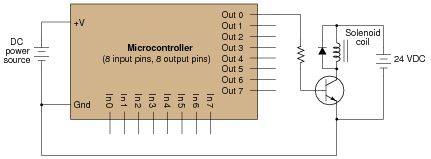
|
|
Unfortunately, a single BJT does not provide enough current gain to actuate the solenoid. With 20 mA of output current from the microcontroller pin and a b of only 25 (typical for a power transistor), this only provides about 500 mA to the solenoid coil.
A solution to this problem involves two bipolar transistors in a Darlington pair arrangement:
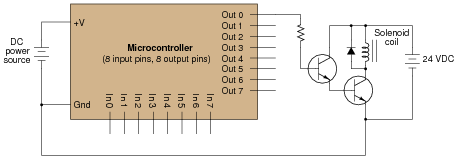
|
|
However, there is another solution yet - replace the single BJT with a single MOSFET, which requires no drive current at all. Show how this may be done:
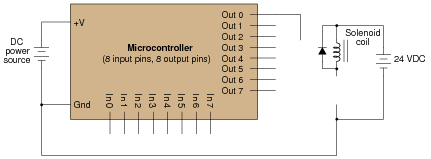
|
|
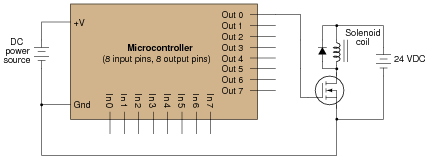
|
|
Notes:
The purpose of this long-winded question is not just to have students figure out how to replace a BJT with a MOSFET, but also to introduce them to the concept of the microcontroller, which is a device of increasing importance in modern electronic systems.
Some students may inquire as to the purpose of the diode in this circuit. Explain to them that this is a commutating diode, sometimes called a free-wheeling diode, necessary to prevent the transistor from being overstressed by high-voltage transients produced by the solenoid coil when de-energized (ïnductive kickback").
Question 2:
Examine the following transistor symbol:

|
|
Identify the following:
- �
- Type of transistor (BJT, JFET, or MOSFET)
- �
- Semiconductor doping (NPN, PNP ; N-channel, P-channel)
- �
- Identification of all 3 terminals (Base, Collector, Emitter ; Gate, Drain, Source)
- �
- Direction of each terminal's current for proper transistor operation (be sure to note whether you are using conventional flow or electron flow notation. If current direction is unimportant, or if there is no current at all, be sure to say so!)
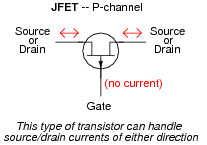
|
|
Notes:
This question probes some basic yet important knowledge about transistor identify and operation. If students have difficulty identifying all the parameters asked for in this question, you need to spend more time on transistor fundamentals before proceeding with any other aspects of transistor circuitry!
Question 3:
Examine the following transistor symbol:

|
|
Identify the following:
- �
- Type of transistor (BJT, JFET, or MOSFET)
- �
- Semiconductor doping (NPN, PNP ; N-channel, P-channel)
- �
- Identification of all 3 terminals (Base, Collector, Emitter ; Gate, Drain, Source)
- �
- Direction of each terminal's current for proper transistor operation (be sure to note whether you are using conventional flow or electron flow notation. If current direction is unimportant, or if there is no current at all, be sure to say so!)
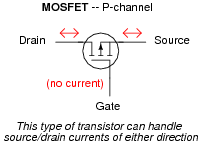
|
|
Notes:
This question probes some basic yet important knowledge about transistor identify and operation. If students have difficulty identifying all the parameters asked for in this question, you need to spend more time on transistor fundamentals before proceeding with any other aspects of transistor circuitry!
Question 4:
Examine the following transistor symbol:

|
|
Identify the following:
- �
- Type of transistor (BJT, JFET, or MOSFET)
- �
- Semiconductor doping (NPN, PNP ; N-channel, P-channel)
- �
- Identification of all 3 terminals (Base, Collector, Emitter ; Gate, Drain, Source)
- �
- Direction of each terminal's current for proper transistor operation (be sure to note whether you are using conventional flow or electron flow notation. If current direction is unimportant, or if there is no current at all, be sure to say so!)
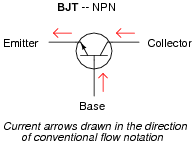
|
|
Notes:
This question probes some basic yet important knowledge about transistor identify and operation. If students have difficulty identifying all the parameters asked for in this question, you need to spend more time on transistor fundamentals before proceeding with any other aspects of transistor circuitry!
Question 5:
Examine the following transistor symbol:

|
|
Identify the following:
- �
- Type of transistor (BJT, JFET, or MOSFET)
- �
- Semiconductor doping (NPN, PNP ; N-channel, P-channel)
- �
- Identification of all 3 terminals (Base, Collector, Emitter ; Gate, Drain, Source)
- �
- Direction of each terminal's current for proper transistor operation (be sure to note whether you are using conventional flow or electron flow notation. If current direction is unimportant, or if there is no current at all, be sure to say so!)
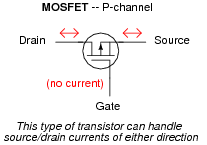
|
|
Notes:
This question probes some basic yet important knowledge about transistor identify and operation. If students have difficulty identifying all the parameters asked for in this question, you need to spend more time on transistor fundamentals before proceeding with any other aspects of transistor circuitry!
Question 6:
Examine the following transistor symbol:

|
|
Identify the following:
- �
- Type of transistor (BJT, JFET, or MOSFET)
- �
- Semiconductor doping (NPN, PNP ; N-channel, P-channel)
- �
- Identification of all 3 terminals (Base, Collector, Emitter ; Gate, Drain, Source)
- �
- Direction of each terminal's current for proper transistor operation (be sure to note whether you are using conventional flow or electron flow notation. If current direction is unimportant, or if there is no current at all, be sure to say so!)
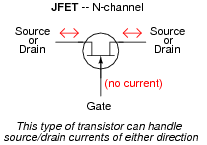
|
|
Notes:
This question probes some basic yet important knowledge about transistor identify and operation. If students have difficulty identifying all the parameters asked for in this question, you need to spend more time on transistor fundamentals before proceeding with any other aspects of transistor circuitry!
Question 7:
Examine the following transistor symbol:

|
|
Identify the following:
- �
- Type of transistor (BJT, JFET, or MOSFET)
- �
- Semiconductor doping (NPN, PNP ; N-channel, P-channel)
- �
- Identification of all 3 terminals (Base, Collector, Emitter ; Gate, Drain, Source)
- �
- Direction of each terminal's current for proper transistor operation (be sure to note whether you are using conventional flow or electron flow notation. If current direction is unimportant, or if there is no current at all, be sure to say so!)

|
|
Notes:
This question probes some basic yet important knowledge about transistor identify and operation. If students have difficulty identifying all the parameters asked for in this question, you need to spend more time on transistor fundamentals before proceeding with any other aspects of transistor circuitry!
Question 8:
Examine the following transistor symbol:

|
|
Identify the following:
- �
- Type of transistor (BJT, JFET, or MOSFET)
- �
- Semiconductor doping (NPN, PNP ; N-channel, P-channel)
- �
- Identification of all 3 terminals (Base, Collector, Emitter ; Gate, Drain, Source)
- �
- Direction of each terminal's current for proper transistor operation (be sure to note whether you are using conventional flow or electron flow notation. If current direction is unimportant, or if there is no current at all, be sure to say so!)
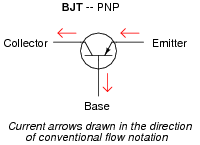
|
|
Notes:
This question probes some basic yet important knowledge about transistor identify and operation. If students have difficulty identifying all the parameters asked for in this question, you need to spend more time on transistor fundamentals before proceeding with any other aspects of transistor circuitry!
Question 9:
Examine the following transistor symbol:

|
|
Identify the following:
- �
- Type of transistor (BJT, JFET, or MOSFET)
- �
- Semiconductor doping (NPN, PNP ; N-channel, P-channel)
- �
- Identification of all 3 terminals (Base, Collector, Emitter ; Gate, Drain, Source)
- �
- Direction of each terminal's current for proper transistor operation (be sure to note whether you are using conventional flow or electron flow notation. If current direction is unimportant, or if there is no current at all, be sure to say so!)
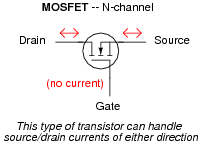
|
|
Notes:
This question probes some basic yet important knowledge about transistor identify and operation. If students have difficulty identifying all the parameters asked for in this question, you need to spend more time on transistor fundamentals before proceeding with any other aspects of transistor circuitry!
Question 10:
Identify what each type of transistor is (MOSFET, JFET, or BJT; N-channel, P-channel, NPN, or PNP, E-type or D-type), and what must be connected to the controlling terminal of each transistor (base or gate) to turn each one on so that the light bulb energizes:
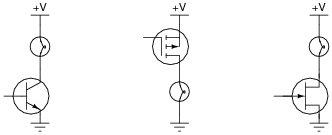
|
|
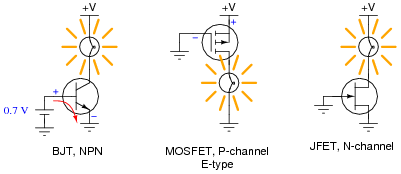
|
|
Follow-up question: for the JFET, which is already ön" with zero voltage applied to the gate, describe what would be necessary to force it into the öff" state.
Notes:
It is very important for students to understand what conditions are necessary to drive any of these transistor types into their ön" states, as a precursor to understanding their function in linear (analog) circuitry.
Question 11:
Identify what each type of transistor is (MOSFET, JFET, or BJT; N-channel, P-channel, NPN, or PNP, E-type or D-type), and what must be connected to the controlling terminal of each transistor (base or gate) to turn each one on so that the light bulb energizes:
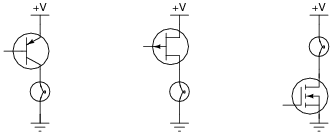
|
|
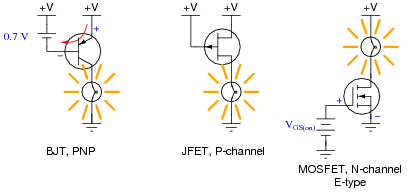
|
|
Follow-up question: for the JFET, which is already ön" with zero voltage applied to the gate, describe what would be necessary to force it into the öff" state.
Notes:
It is very important for students to understand what conditions are necessary to drive any of these transistor types into their ön" states, as a precursor to understanding their function in linear (analog) circuitry.
Question 12:
Shown here is the schematic diagram for a simple automotive ignition system, to produce pulses of high voltage sufficient to energize spark plugs in an engine:
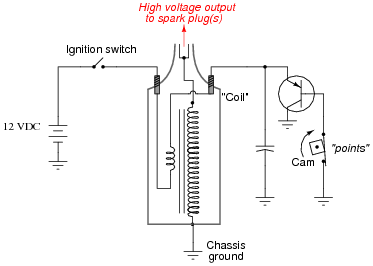
|
|
An engineer decides to replace the BJT with a MOSFET, and arrives at the following circuit design:
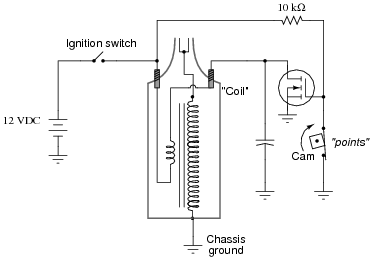
|
|
Explain how this revised circuit works. When does the MOSFET conduct current, when the point contacts are open or closed? How does this compare to the working of the previous (BJT) circuit? What purpose does the 10 kW resistor serve?
Notes:
If this were a real ignition system, the timing would have to be adjusted, as the spark will now be produced every time the points close rather than every time the points open as it did before (with the BJT). Discuss the operation of this circuit with your students, asking them to explain how they know the MOSFET's status (and the BJT's status, for that matter).
Question 13:
In this system, the voltage output of a digital timing circuit controls the charging and discharging of a resistor-capacitor network. The inner workings of the digital timing circuit are hidden for simplicity's sake, but we may model it as a two-position switch, outputting either a "high" voltage signal (full supply voltage) or a "low" voltage signal (ground potential) at regular intervals:
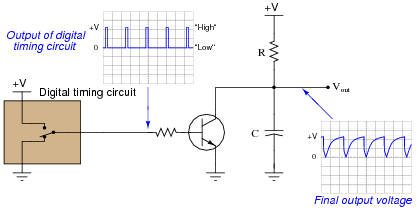
|
|
First, identify what signal level from the digital circuit ("high" or "low") causes the capacitor to charge, and what level causes it to discharge. Then, replace the BJT with a suitable MOSFET to accomplish the exact same timing function:
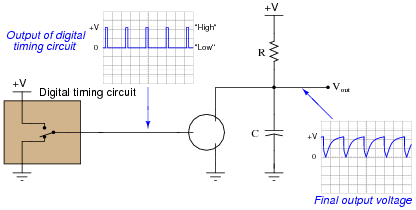
|
|
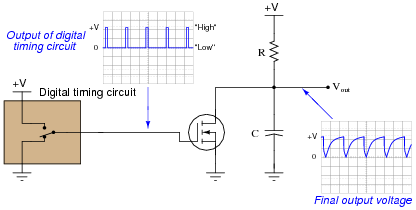
|
|
Follow-up question: explain why no resistor is required in series with the MOSFET gate as there was with the BJT base in the original circuit version.
Notes:
This circuit could be used as an introduction to the 555 timer, since that IC uses the same scheme for capacitor discharge.
